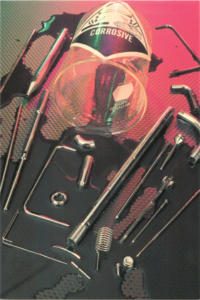
Corrosion resistance and heat resistance are the primary reasons for specifying stainless steel. For these reasons, temperatures and chemicals are among the issues to consider when determining the right grade for an application.304 and 316 alloys retain their strength, toughness, and corrosion-resistant properties in high temperatures.
Lower alloyed grades resist corrosion in atmospheric and pure water environments; high alloyed grades can resist corrosion in most acids, alkaline solutions, and chlorine-bearing environments making their properties useful in process plants. Chromium is the alloying element that imparts to stainless steels their corrosion resistance qualities by combining oxygen to form a thin invisible chromium-oxide protective film on the surface. The addition of molybdenum can increase the hardenability, toughness and tensile strength. The main reason to add molybdenum is to reduce pitting.
Guidelines for Choosing Stainless Steel
Corrosion and Heat Resistance
The primary reason for specifying stainless steel. The specifier must know the environment and the degree of corrosion and heat resistance required.
Mechanical Properties
The mechanical properties of stainless steel determine the range of usefulness and life expectancy. For stainless steels, the combination of corrosion resistance and strength would be the basis of selection.
Fabrication Operations
Secondary operations can transform a simple tube into the part needed. CNC Machining, cutting, welding, bending, and precision grinding are among the operations to tailor your tube to the part you need.
Total Cost
When the total life cycle costs are considered, stainless is often the best option. Maintenance-free material add to the cost-saving benefit.
Type 304 stainless is the most commonly used stainless steel followed by type 316. Type 304 contains both chromium (between 18% and 20%) and nickel (between 8% and 10.5%)Type 316 contains chromium (between 16–18%), nickel (10–12%), and molybdenum (2–3%), with small (<1%) quantities of silicon, phosphorus & sulfur also present.
Purchasing a lab sample kit lets you experiment with sizes before running a production run. The kit features 90 pieces of 40” long hypodermic tubing in a full range of sizes from 6 gauge to 33 gauge – all with a variety of wall thicknesses.



